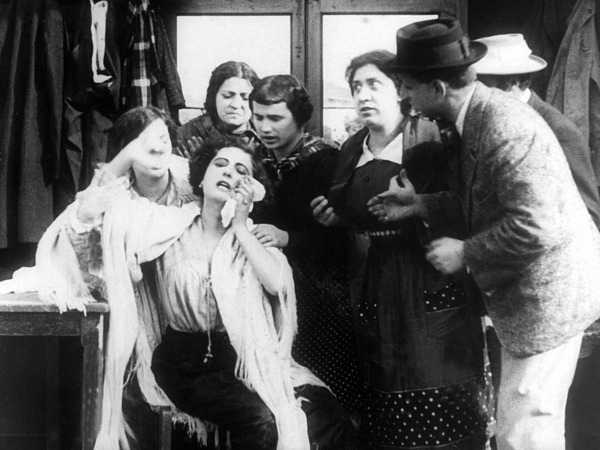ASSUNTA SPINA
Gustavo Serena, [Francesca Bertini] (IT 1915)
Accompagnamento musicale composto ed eseguito dal vivo da/Score composed and performed live by John T. La Barbera con/with Carlo Aonzo.
The DCP was produced by the Cineteca di Bologna at the Immagine Ritrovata laboratory from the internegative of the version restored photochemically in 1993.
“Memorable. Worth remembering or easily remembered, because of being exceptional or extraordinary.” This definition from the 2012 Sansoni Italian dictionary is correct: Assunta Spina is a memorable film; the dictionary entry describes it exactly.
Assunta Spina is “worth remembering” as the best surviving example of a small but significant series of films shot in the mid-1910s and drawn from the verismo repertory of late 19th and early 20th century drama. Together with Sperduti nel buio (Morgana Films, 1914) and A San Francisco (Caesar-Film, 1915), unfortunately both lost, Assunta Spina made a significant contribution in launching the vocation for realism that was to be one of the essential hallmarks of subsequent Italian cinema.
At the same time, it is an “extraordinary” film, out of the ordinary with respect to the canon of Italian filmmaking at that period, which was largely devoted to historical and mythological stories, and dramas of passion inspired by the Decadentismo movement of the late 19th century.
Based on the play by Salvatore Di Giacomo, Assunta Spina brings to the screen the contradictory natures of a city – Naples – making it one of the leading characters. On the one hand, picture-postcard views of the city’s best-known sights – Posillipo, Marechiaro, the Bay – are contrasted with scenes “from life”, filmed in the narrow alleys, piazzas, and markets of the city’s working-class neighbourhoods; on the other, the camera fully conveys the passionate nature of its inhabitants, whose emotions – whether noble or base – can be so overpowering as to trigger abuse, murder, and tragedy.
The driving force and truth with which Naples and its people reveal themselves to the camera are due in large part to the contribution of Francesca Bertini. By the time shooting began in 1914, the Neapolitan actress was already an established diva. She made her debut very young, playing one of the laundry workers in the first performance of Assunta Spina, staged in 1909 at the Teatro Nuovo in Naples. When film producer Giuseppe Barattolo offered her the lead in the screen adaptation, Bertini accepted, on condition that she would also be entrusted with control of the filming. As claimed by the actress herself, and verified by Gustavo Serena, her co-star and himself officially credited as the film’s “direttore artistico”, Francesca Bertini effectively played a decisive part in the mise-en-scène of Assunta Spina, collaborating on the drafting of the screenplay and participating in the scouting and identification of the most appropriate locations. In addition, assisted by her trusty cameraman Alberto Carta, she was not averse to operating the camera when the script didn’t require her to be in front of it.
Many years later Bertini said of the film: “It was all true… There was a lot of truth in this film. Everything was authentic…” Beyond what comes from the self-conscious movements of the extras in the street scenes, or the artifice-free shots of the simple slum interiors and crowded streets of the city, the truth that emerges so forcefully from the screen springs from the looks, gestures, and expressiveness of Bertini. With her performance, by turns passionate or internalized, at times stylized, but nonetheless and always deeply felt, Bertini subverts the grandiloquent, Baroque rules of acting the femme fatale which had until then characterized the prima donnas of Italian cinema. Instead of the drapes of brocade that languorous, wanton divas usually wrap around themselves, Assunta wears a simple white shawl, like a good-luck charm to ward off evil, which she uses as the need arises either as a shield or weapon, and which not by chance will disappear from her shoulders in the final act of the tragedy, leaving her alone and unprotected, at the mercy of pitiless fate.
Giovanni Lasi

regia/dir: Gustavo Serena, [Francesca Bertini].
scen: Gustavo Serena, Francesca Bertini; dal dramma omonimo di/based on the drama by Salvatore Di Giacomo (1909).
photog: Alberto Carta.
scg/des: Alfredo Manzi.
cast: Francesca Bertini (Assunta Spina), Gustavo Serena (Michele Boccadifuoco), Carlo Benetti (Don Federigo Funelli), Alberto Albertini (Raffaele), Antonio Cruicchi (padre di Assunta/Assunta’s father), Amelia Cipriani (Peppina), Alberto Collo (una guardia/a guard).
prod: Giuseppe Barattolo, Caesar-Film, Roma.
riprese/filmed: autunno/fall 1914, Napoli.
v.c./censor date: 29.05.1915 (n. 9173).
première (Roma): 28.10.1915.
copia/copy: DCP, 67′ (da/from 35mm, 1368 m. [orig. 1690 m.], 18 fps, col. [imbibito e virato/tinted & toned]; did./titles: ITA.
fonte/source: Cineteca di Bologna.


 Italiano
Italiano